
In the River TAKAHARA --Vol.90--

The junction of the white-water creek. The upper reaches of the barrier was filled with sand and pebbles.
The Right Fork
After remembering the sunless valley, I suddenly missed a light creek with open scenery. Now I wanted to go to the source area of the River Takahara, instead of its tributaries.The River Gamata, flowing at the upper reaches of the River Takahara, divided into 2 streams up the new spa of Hodaka. We called them the right and left forks, facing upstream. After we passed the junction, both forks had steep slopes and took the scenery of the source area.
Walking upstream along the current like climbing the stairs, I felt refreshed. To the right, there were the ridges of the Hodaka range, more than 3000m high. Beyond our destination, Mt. Yarigatake soared into the cloud. Even in the daytime of midsummer my body was always exposed to the cool breeze, in contrast to the heat of the lowland.
I first came here in 1986, the same year of the River Nagatou, about which I had just talked from vol.86 to vol.89. I fished upstream to the source area with my old fishing companion, Mr. Shohei Katoh. Then I came here several times but not so many.

The Hodaka range to the right. Mt. Yarigatake in the background. To the left, Mt. Kasagatake, whose top is rising above the clouds. The source area of Kasadani is beyond there.
It was simply because the river had too much water until the rainy season was over and all remaining snow melted and flowed down. As one of the sluice gates was built at the lower reaches of the junction of the two forks, there was a small amount of water downstream and it became suitable for fishing there after the snow melting season. But it was not true with the upper reaches of the sluice gate. White water flowed down the mountain surface like a long waterfall. There was no pool or calm surface to cast the fly.
I think of why such a river had some char but actually almost every main point had them and their number was fairly large when the water level became suitable.
A White-Water Creek
There are 2 courses to fish the right fork. One is that going upstream from the junction. There is rather a little water before we reach the last sluice gate. After we pass there, water increases and the slope becomes farther steeper. Many barriers against landslip look like pyramids seen from far away. The scenery is rather unattractive but the fish are staying at the whole course. We can fish up to the junction of the white-water creek, usually a dry creek, flowing from the right side and walk back down the mountain trail. That is one of the good courses if we do not fish the whole area all day long.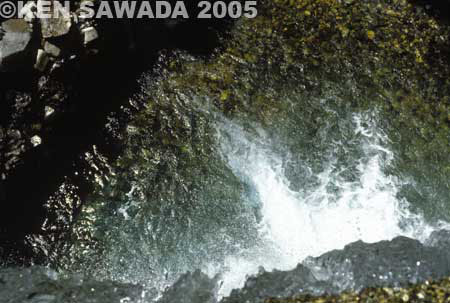
I looked down, standing on the barrier. The char can plunge into the bottom but never come back.
The other course is fishing only the source area, giving up the lower reaches. First we walk along the mountain trail to Mt. Yarigatake and then climb down to the valley along the white-water creek which crossed the mountain trail. As I mentioned, the white-water creek is usually a dry creek but suddenly changes into a raging torrent like a waterfall once the afternoon shower falls in the mountain. Not a few climbers are said to have been washed away and died when they tried to cross this creek in the rain.
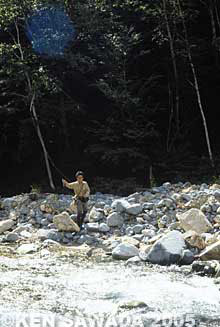
The upper reaches of the barrier was covered with white foam and the river flowed like a channel.
One afternoon in the end of July, I went there for the first time. Mr. Shohei Katoh and I took the latter course to climb down the white-water creek to the right fork. About 1 p.m. we turned the mountain trail and descended the slope where many giant rocks were piled up, different from the ordinary riverbed. Fortunately we could stand on the last barrier against landslip built on the right fork.
I recognized the place as the top of the barrier because I saw the concrete wall on the mountain surface just downstream. I was not sure when the barrier was built but the bank we were standing on was a slope covered with pebbles. The barrier was completely buried with pebbles and sand.
For some distance, the river flowed through the sand mound like a channel. There was no good point or no sign of fish, either. But I thought that char would frequently bite the fly near the evening. I put size 10 Wild Canary, the largest dry fly in my fly box, to the leader tip.
I started fishing. For the first 100 m. Wild Canary slid down on the dull stream at a high speed in vain.
A Mirror-like Surface
The valley flowed through the sand plain and then along the bedrock. The scenery dramatically changed there and the clear water filled the bank where so many giant rocks were piled up, instead of gravel. The water flowed deep into the valley, forming a lot of spots of falling water, like stairs.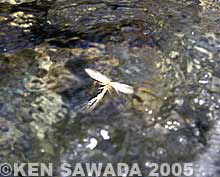
Size 10 Wild Canary is a perfect pilot fly.
Char must stay upstream! Every angler believes so when he sees such nice pockets, one after another. I set Wild Canary afloat on a mirror-like surface between the falling water and the rock. The fly slowly flowed through the mirror part to the falling water but was pushed back to the mirror part again by the force of white foam.
I waited patiently. Finally a dark brown lump broke the surface calmly. It swallowed the fly so slowly that I felt irritated. It was a char, a little less than 30cm and had a good shape. But it had rather deep colours for this season and its yellow spots and white edge of the fins were so bright that I almost misrecognized it as a Brook Trout. Its colours were almost the same as the fish caught in the beginning of the season. It was the end of July but looked like early summer here.
I wanted to show Shohei my char hanging on the line. I looked up at him. He was pulling his fish to him. Knowing that both of us caught char, we smiled at each other.
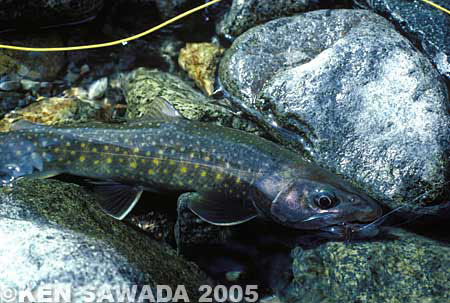
The char was blackish and bony.
The same scenery spread for another 100m. Every deep pool was not so big and had rather a large amount of water yet, which made the most part of the deep pool covered with white foam. There was always a small mirror part on either side of the foam. Although I could not see the inside of the water because of the light condition, every deep pool seemed to be the perfect point for char fishing.
Char almost always broke the surface at main pockets. But they did not break the surface so soon but came near to the fly slowly after 3 or 4 presentations in the same way as my first char.
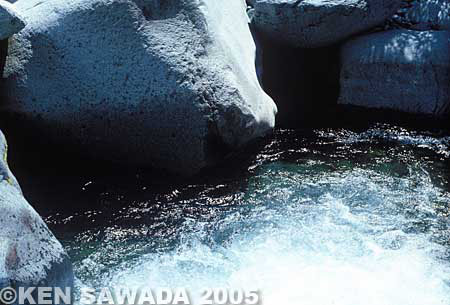
The pools and pockets surrounded by giant rocks. A large amount of water made the mirror part small.
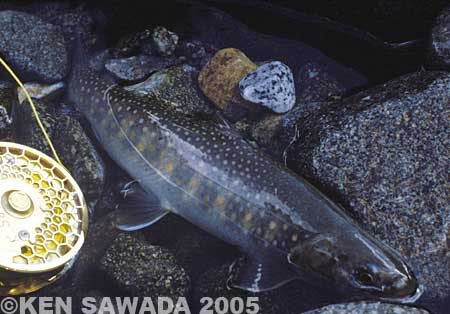
Yellow spots of this char remind me of Brook Trout. Next the fish is Honeycomb reel completed in 1986.
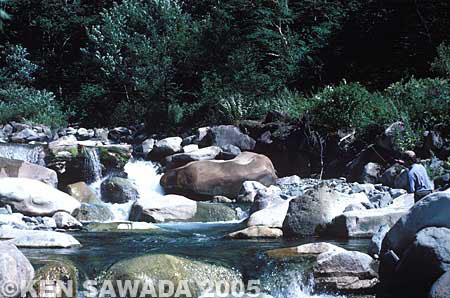
There appeared a lot of attractive pocket-like spots, one after another, on the bank filled with giant rocks.
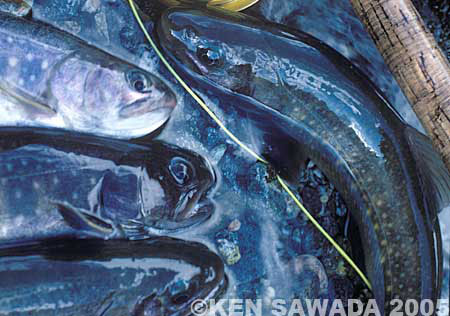
Those char were caught successively. All looked blackish.
I thought that fish had no interest in the water surface now. I decided to change the fly. I removed the leader and picked up 3X leader of 7 1/2 ft. from the cast wallet. Size 10 Jock as a lead fly and size 8 Peacock Queen as a dropper, both had been put to it in advance.
I drove those wet flies into the white foam and made them go down into the bottom of the mirror part. I hoped I would get a bite soon.
For some reason my choice was not so effective. I could not say that I failed because I got some catch. However, the response from the char was still poor. Even after I changed the dry fly into those wet flies, my pace of fishing upstream became slower and slower.
As we walked upstream, the scenery of the valley became less steep. Char responded suddenly better to the dry fly of Shohei, whereas they still responded poorly to my wet flies. His dry fly performed more speedily than my wet flies.
If the response to my wet flies had been much poorer, I would have chosen the dry fly again immediately. But I could not, feeling as if I had left something half done.
-- To be continued --
- NET SHOP INFORMATION
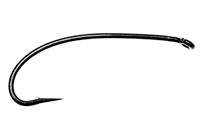
SL6 Black Spey Hooks
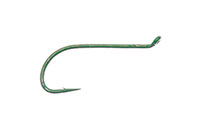
DU3 Limerick Spinner Hooks
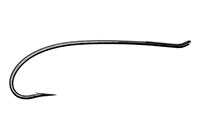
SL4 Single Bartleet Hooks
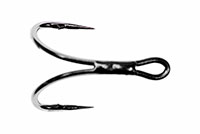
XD1 Tube Fly Double Hooks
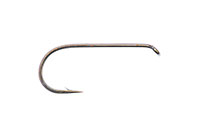
DD2 Flat Perfect Hooks
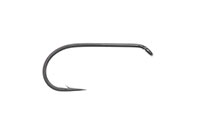
DD1 Black Terrestrial Hooks
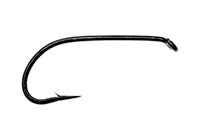
TD4 Old Limerick Wet Hooks
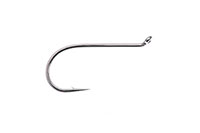
DU1 Silver May Hooks
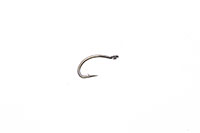
MU1 Flat Midge Hooks
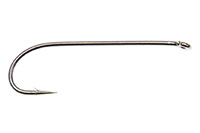
LD3 Long Limerick Hooks
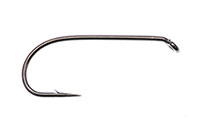
TD2 Summer Sproat Hooks
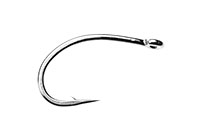
XS1 Tube Single Silver Hooks
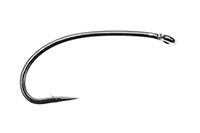
TD6 Siver Sedge Hooks

SL5 Black Spey Hooks

DU3 Limerick Spinner Hooks
- TROPHY CLUB
- FLY SHOW
- EXHIBITION
- MASTERS`
- FLY DRESSING CONTEST Archives
- TRAVELLER Archives
- TACKLE IMPRESSIONS Archives
- ANGLERS` PHOTO GALLERY Archives
- ----------------------------------------------
- トロフィークラブ
- フライショー
- エキシビション
- マスターズ
- フライドレッシング・コンテスト・アーカイヴ
- トラヴェラー・アーカイヴ
- タックル・インプレッション・アーカイヴ
- アングラーズ・フォトギャラリー・アーカイヴ
株式会社サワダ 185-0021 東京都国分寺市南町3-13-4
SAWADA'S INC. 3-13-4 Minamicho, Kokubunji, Tokyo 185-0021, Japan
写真・ドキュメントの無断転載を禁じます。
All the images and documents found on this site are owned by Ken Sawada and may not be used without permission.
But, link to this site is FREE.
Copyright © 2000 - 2024 SAWADA'S INC.. All rights reserved.
SAWADA'S INC. 3-13-4 Minamicho, Kokubunji, Tokyo 185-0021, Japan
写真・ドキュメントの無断転載を禁じます。
All the images and documents found on this site are owned by Ken Sawada and may not be used without permission.
But, link to this site is FREE.
Copyright © 2000 - 2024 SAWADA'S INC.. All rights reserved.
